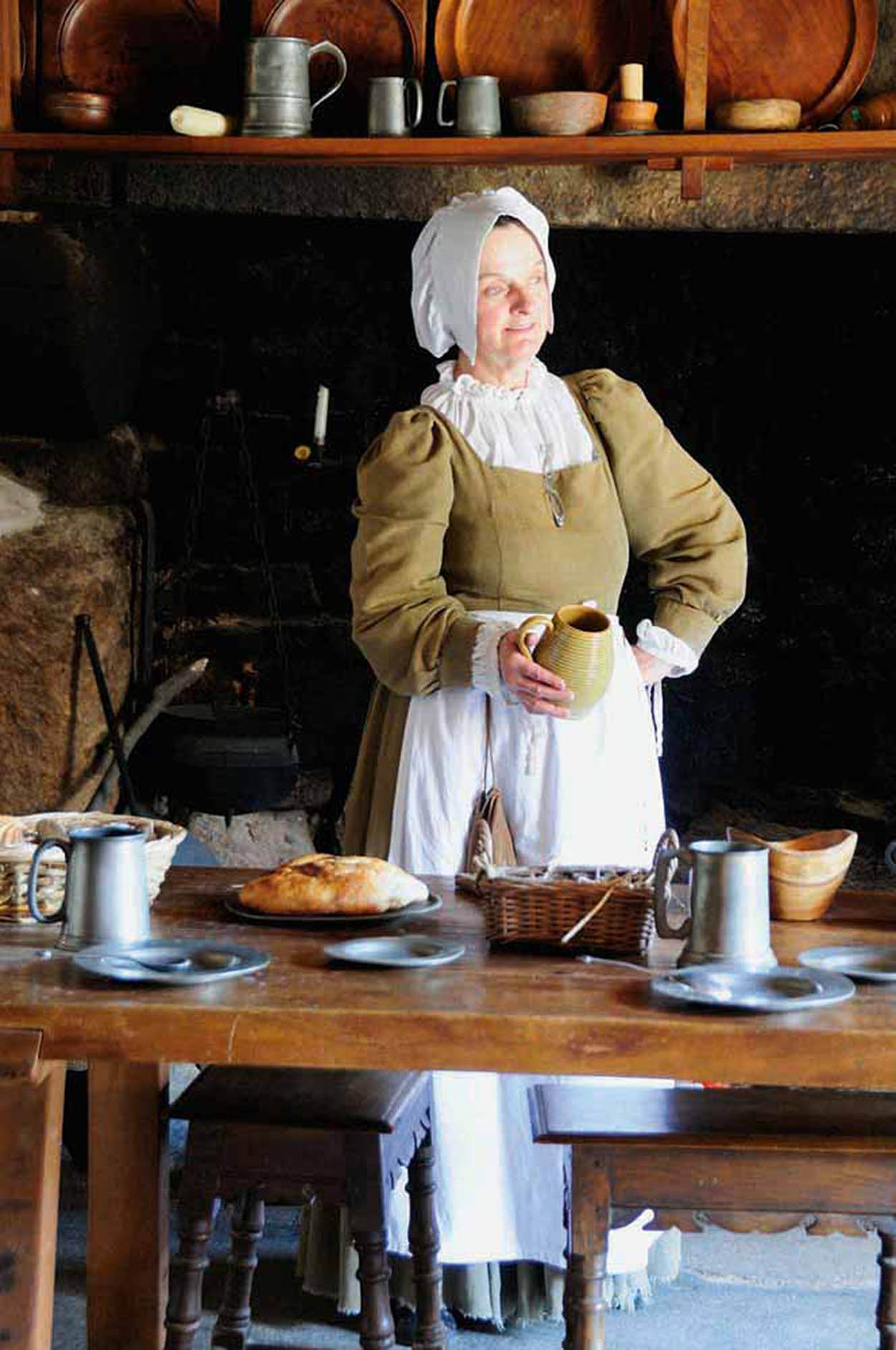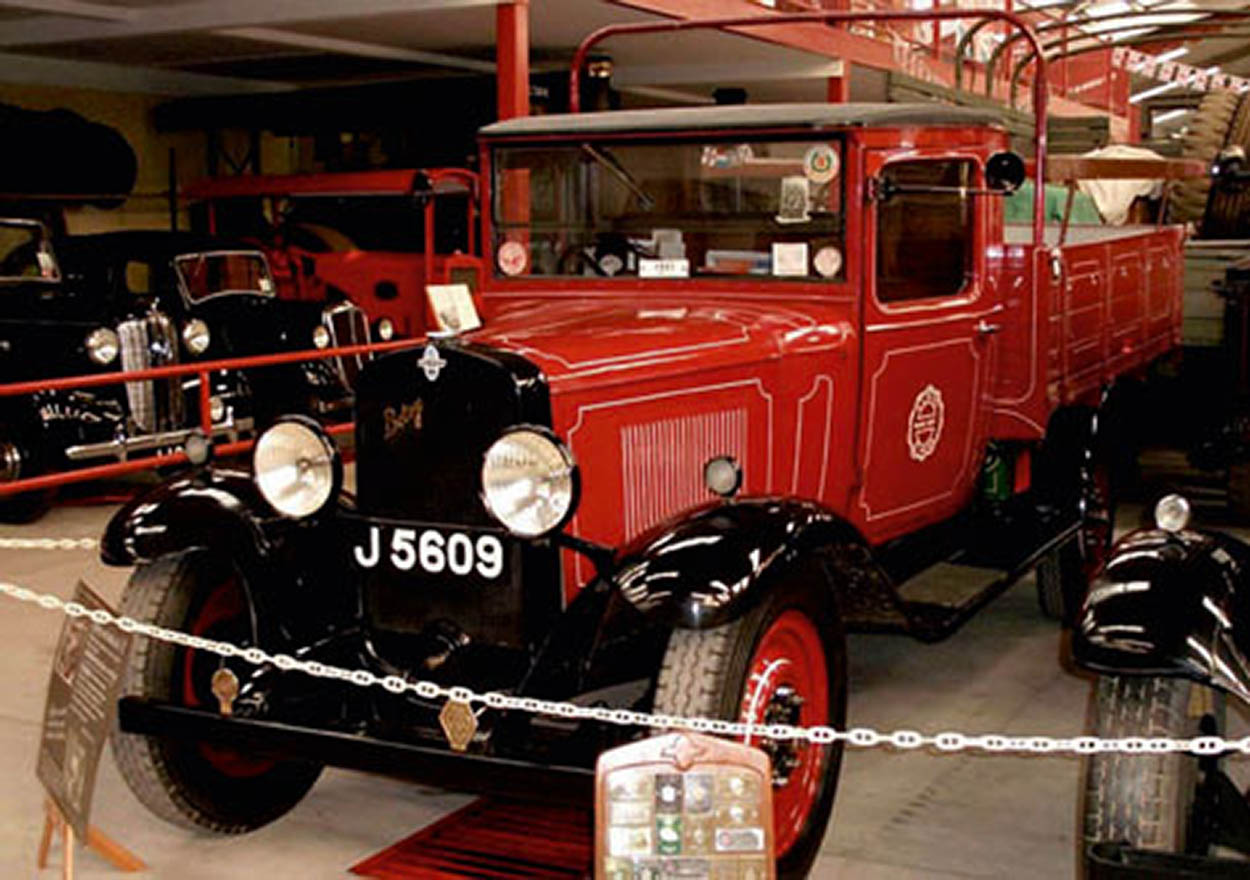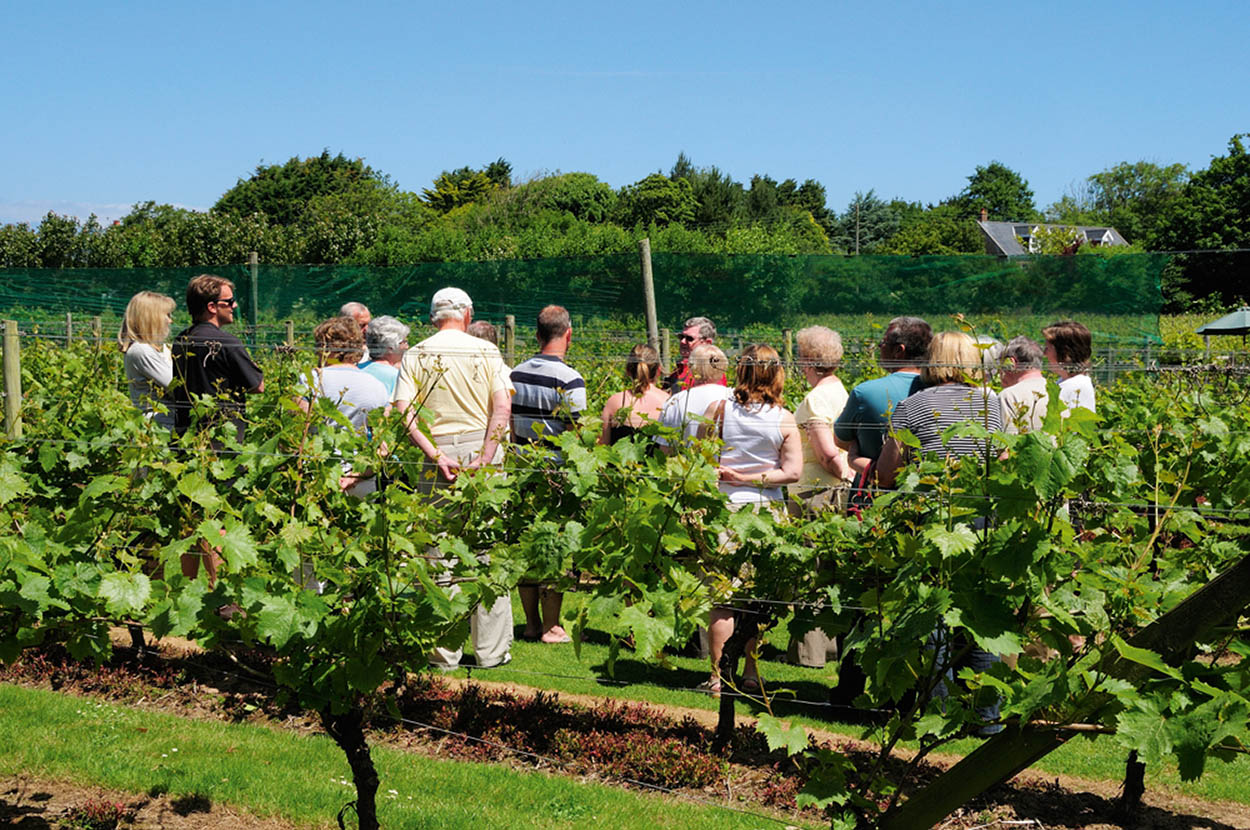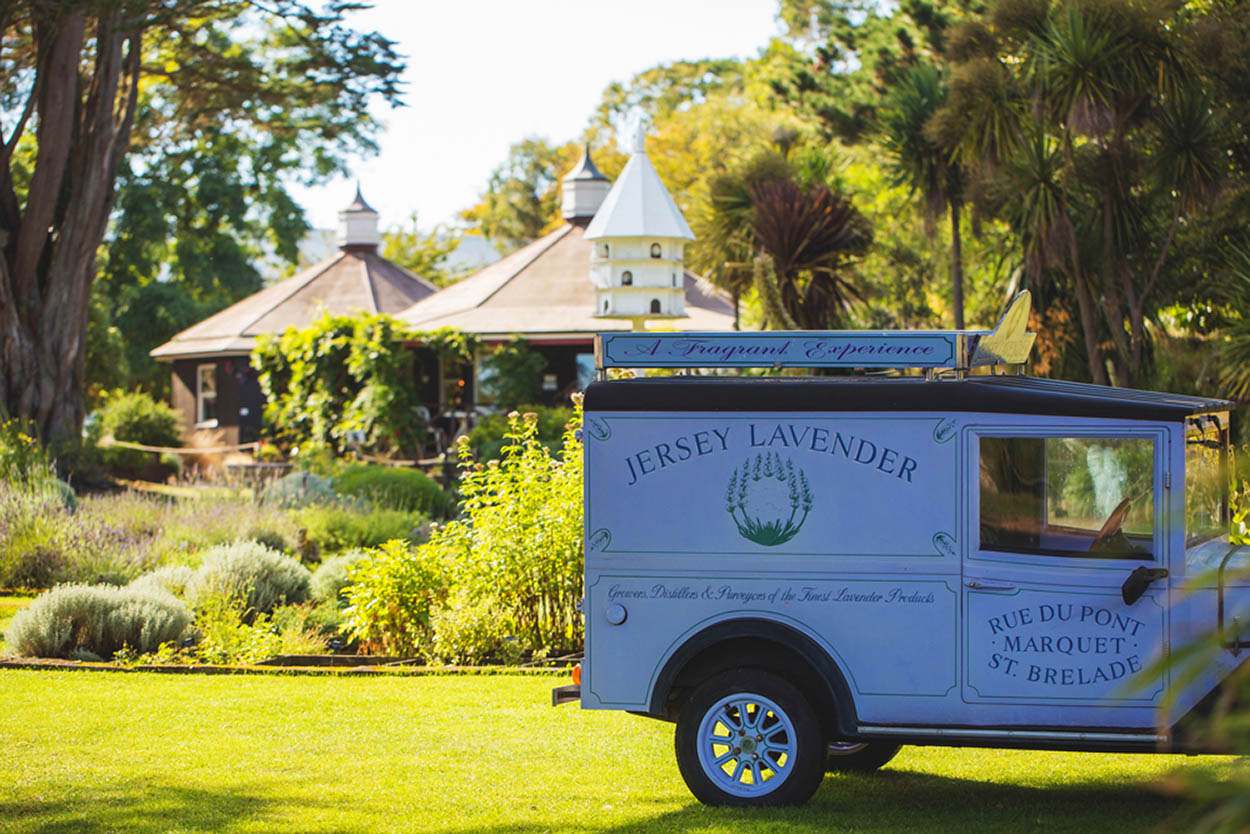
Spectacular swathes of lavender at Jersey Lavender Farm.
Mockford & Bonetti/Apa Publications
Tour 4: Flowers and Farming
Full of botanical and rural delights, this whole-day driving or cycling tour of 14 miles (22km) takes you to a heritage museum, vineyards, watermills and a fragrant lavender farm.
Highlights

Spectacular swathes of lavender at Jersey Lavender Farm.
Mockford & Bonetti/Apa Publications
Away from the coast you’ll find a surprisingly unspoilt landscape of valleys, woods, country lanes and farming land. Agriculture is no longer a main source of income for Jersey, but farming is still a way of life for at least some of the islanders. Half of the land is agricultural, and the sunny south-facing slopes yield Jersey Royal potatoes and tomatoes, while the famous Jersey cow provides islanders with milk, cream and butter.
The temperate climate, long hours of sunshine and rich soil make Jersey a gardener’s paradise. Each year the island puts on a programme of open gardens, demonstrations, flower shows and environmental walks. Flowers are grown both for export and for the decoration of floats at Jersey’s celebrated Battle of Flowers. The island is also famous for its orchids, both wild and cultivated, as well as other species of rare wildflowers. During the August summer flower show the Royal Jersey Agricultural and Horticultural Society (www.royaljersey.co.uk) arranges four shows a year (in March, June, August and October) with some spectacular floral and vegetable displays.
Owners of private gardens occasionally open their gates to the public on Sundays at other times of year. For information visit www.jersey.com.
Hedge Veg
When you’re driving along the lanes inland you may come across fresh produce (especially Jersey Royals) sold at roadside stalls outside farms and private houses. You choose what you want and leave the correct change in an honesty box. You used to see them everywhere but now many have been replaced by the growing number of farm shops.
Battle of Flowers
From St Helier, follow the signs for ‘The West’ and the A1, taking you along the Esplanade. This becomes Victoria Avenue, venue of the annual Battle of Flowers which takes place every August and features bands, celebrities and a long parade of spectacular floats made of flowers. Tickets can be purchased online at www.battleofflowers.com.

Cash and carry along the country lanes.
Mockford & Bonetti/Apa Publications
Apart from breaks during World War I and the German Occupation in World War II, the event has taken place every year since 1902, when the first ‘Battle’ celebrated the Coronation of King Edward VII. It is one of the largest floral carnivals in Europe.
Flowers and Farming


The cluster of faithfully restored buildings at Hamptonne Country Life Museum capture the spirit of rural Jersey.
Mockford & Bonetti/Apa Publications
A day or two before the event volunteers can be seen busily cutting blooms and gluing them to the floats, though these days many are made of paper. If you happen to miss the Battle of Flowers, some of these amazing creations can be seen displayed around the parishes for a few days following the event.
Before the 1960s it really was a battle, with floats being stripped and both participants and onlookers pelting each other with flowers. Nowadays the floats remain intact, and it’s more about marching bands and beauty queens. The event takes place on the second Friday in August, with an illuminated Moonlight Parade the Saturday evening after.

A goodwyf gives you the latest seventeenth-century farming gossip.
Mockford & Bonetti/Apa Publications
Waterworks Valley
When the road divides, follow signs for the A1 which take you along the inner coastal road. Keep to this road until you see a turning to the right with a small sign for Waterworks Valley 1 [map] (C118). The road twists up through the lush green valley. This is one of Jersey’s loveliest natural features, with leafy glades and woodland paths. The stream here used to power six watermills – hence the original name of the road, ‘Le Chemin des Moulins’. The late nineteenth century saw the construction of the 3-mile (5km) long Millbrook reservoir, followed later by the Dannemarche and Handois reservoirs to the north, giving the valley its somewhat pedestrian name.

Traditional apple press in the cider barn at Hamptonne.
Mockford & Bonetti/Apa Publications
Hamptonne Country Life Museum
Beyond the Dannemarche Reservoir, fork left (on the C119) to get to the Hamptonne Country Life Museum 2 [map] (La Rue de la Patente; www.jerseyheritage.org), which is tucked away in a lovely rustic setting, surrounded by gardens, meadows and woodland.
Pallot Museum
This fascinating collection of steam and farm machinery, motor vehicles, vintage bikes and organs was put together by the late Don Pallot, a talented Jersey engineer. He invented farming implements to facilitate life for Jersey farmers, among them the Pallot Elevator Digger and the Last Furrow Reversible Plough. On Thursdays you can travel in a Victorian steam-drawn coach. (Located east of Hamptonne, off the A9 on Rue du Bechet, Trinity; www.pallotmuseum.co.uk; bus route No 5 stops nearby).
The group of farmhouses and outbuildings of this 15th century farm have been restored to demonstrate several hundred years of the island’s rural heritage. Named after their former owners, the Langlois, Hamptonne and Syvret families, the interiors have been renovated as the homes of farming families of the seventeenth and eighteenth centuries.Syvret House gives an insight into 1940s rural life including farming traditions, day-to-day family life, language, religion and the German Occupation.
The nearby cider barn (pressoir) houses the apple crusher and twin-screw apple press that are still used every autumn to make cider. During La Faîs’sie d’Cidre (Cider Festival) in mid-October you can see the cider being made in the old-fashioned way, with a horse crushing the apples and the juice then extracted on the press.
This is very much a living museum, often with a farmer’s wife (goodwyf in the Jersey patois) in period costume to tell you tales of the English Civil War or the latest gossip from the seventeenth-century farming community; or you might find a spinner or lace-maker demonstrating bygone skills. Youngsters can follow a nature trail, meet the Hamptonne piglets and calves or test their knowledge with activity sheets or puzzles in the Children’s Room.

A Jersey builder’s truck; a 1931 Chevrolet 30 cwt lorry.
The Pallot Steam, Motor & General Museum
Make sure you stop at the Hamptonne Café, which serves freshly-made cakes and snacks.
La Mare Wine Estate
Continue along the B39 as far as St Mary’s Village and then follow the signs along the C103 towards the Devil’s Hole and La Mare Wine Estate 3 [map] (www.lamarewineestate.com). From a small vineyard La Mare has grown into one of Jersey’s main tourist attractions, as well as a wedding and corporate venue. The 25-acre (10-hectare) wine estate produces red, white, rosé and sparkling wines as well as apple brandy, and Jersey gin and vodka made from Jersey Royals. Guided tours of the vineyards, winery, distillery and chocolate kitchen include tastings along the way.
The sparkling wines are made according to the méthode champenoise – Jersey is on the same degree of latitude as Champagne; they also make a sparkling cider, apple brandy, along with jams, marmalades, jellies and Jersey black butter (a type of preserve, not a butter).
If you don’t make it to La Mare itself you can always purchase their products from the Maison La Mare in King Street, St Helier, or order them online.
St Peter’s Valley
Return to St Mary’s Village and take the B26, signed to St Peter’s Valley. This will eventually join the A11, which continues through this lovely green valley – it was here that Queen Victoria was brought when she asked to see the most beautiful spot on the island. The valley was the site of six watermills, used mainly for grinding flour.

Daily guided tours with tastings will take you through the vineyards, orchards and distillery of La Mare Wine Estate.
Mockford & Bonetti/Apa Publications

Jersey cows in St Peter’s Valley.
Visit Jersey
Turn right on to the B58, just over a mile along the A11, to see the only surviving fully working water mill on the island, the Moulin de Quétivel 4 [map] (Mont Fallu; www.nationaltrust.je). A mill has operated here intermittently since feudal times, the current one dating from the eighteenth century. Abandoned in the early twentieth century, it was revived by the Germans during the Occupation, only to fall into disrepair again and be further damaged by fire in 1969. It was eventually brought back to working order and beautifully restored by the National Trust in 1979.

A sparkling wine selection from La Mare Wine Estate.
Mockford & Bonetti/Apa Publications
The top floor has an exhibition on the history of milling, while the first and ground floors demonstrate how the mill works. There is a shop selling freshly ground organic flours and a wide range of locally produced gifts and a film showing how cabbage loaves (still sold in some bakeries on the island) are made in gorse ovens.
You can take the footpath from the mill to the mill pond, through red squirrel-inhabited woodland, or follow another path to Tesson Mill, and to the beach beyond this.
Le Moulin de Tesson (Tesson Mill), at the entrance to St Peter’s Valley, has also been restored by the National Trust. There has probably been a mill on the site since the eleventh century. To fund the restoration of the waterwheel and steam-engine room the National Trust had to grant a long lease to convert the interior to residential apartments. A short film relates the history of the mill. The site was temporarily closed recently for archaeological surveys.

St. Brelade has free-draining soil and a mild climate, providing the perfect growing conditions for lavender.
Visit Jersey

Moulin de Quétivel is the only working mill left in St Peter‘s Valley, and still grinds its own flour.
National Trust for Jersey
Jersey Lavender
Continuing on the B58, go straight over the next crossroads for the A12. Turn left here and right at the roundabout which bypasses the airport and brings you into St Brelade. Just after the Quennevais shopping precinct turn left along the B25, signposted to Jersey Lavender 5 [map] (www.jerseylavender.co.uk). The fields of lavender, covering 9 acres (4 hectares), provide a Provence-like blaze of purple throughout the summer. This is a family-owned and -run business that was set up in the 1980s. The garden contains around sixty different varieties of lavender, plus dozens of culinary, medicinal, aromatic and dyers’ herbs. The lavender is cut by hand, distilled on site and the essential oils matured and blended with other ingredients to produce eau de toilette, colognes, soap, lotions and lavender bags. You can join a guided tour of the farm, where all the different stages of harvesting and production are explained, and there are also audio tours, and talks about the distillation process.

For plant-lovers, there are over sixty varieties of lavender on view at Jersey Lavender, and most are for sale.
Visit Jersey
Jersey National Trust
If you’re a member of the National Trust, make sure you take your card when you go to Jersey. The island has its own National Trust (www.nationaltrust.je) dedicated to preserving sites of historic, aesthetic and natural interest. It is the largest private landowner on Jersey, maintaining over 170 sites. Admission to the sites is free for NT members on production of a membership card. The organisation has a year-round programme of free, themed guided walks; collect a leaflet from the National Trust office at The Elms, La Chève Rue, in St Mary for further details.
The best time to visit is late May/early June to late July/early August – the lavandage or lavender harvest is usually over by early-August, but visitors can still watch the distilling and bottling processes and purchase products made from the lavender essence. Further attractions are the herb garden, nature trail and Sprigs Café where lavender finds its way into a number of sweet and savoury dishes.

The Jersey National Trust was founded in 1936.
Visit Jersey
Judith Querée’s Garden
Plant enthusiasts should not miss an opportunity to take a tour of Judith Querée’s Garden, set in a peaceful valley in the parish of St Ouen and encircling a 350-year-old traditional Jersey granite cottage. It is only just over 0.25 acres (0.1 hectares) in size but it manages to pack in around two thousand (mainly herbaceous) perennials from all over the world, many of them rare and unusual. Judith gives personal guided group tours of her award-winning garden by appointment. The full address is: Creux Baillot Cottage, Le Chemin des Garennes, Leoville; www.judithqueree.com. Not suitable for young children.
To return to St Helier take the B25 eastwards and join the main coastal road back to St Helier.
Detour to Eric Young Orchid Foundation
Floral enthusiasts should not leave Jersey without a visit to the Eric Young Orchid Foundation 6 [map] (Victoria Village; http://ericyoungorchid.org), tucked away in the heart of the countryside in the parish of Trinity. From St Helier take the ring road, following signs to ‘The North’, then turn off for the A8 to Trinity. After half a mile, turn right, following signposts for Les Grands Vaux and the Orchid Foundation. The road takes you past Les Grands Vaux reservoir, then to Victoria Village, where the Foundation is signposted to the left.
The late Eric Young devoted his life to breeding new hybrids of orchid, and his exhibitions won prestigious awards. He first established a collection in Jersey in 1958, and within a decade it was recognised as one of the leading private collections in Europe and multiple times winner of the Chelsea Flower Show Gold Award. Young’s ambition to set up an orchid foundation open to the public was achieved, but he died in 1984 at the age of 73, before the project was completed.
The fruits of his lifelong efforts can be seen in the growing houses where exotic orchids of dazzling colours are set against a backdrop of ponds, branches, rocks and raised beds.

There is a dazzling display of orchids on show at the Eric Young Orchid Foundation.
Mockford & Bonetti/Apa Publications

Immerse yourself in exotic orchid blooms at the Eric Young Orchid Foundation.
Mockford & Bonetti/Apa Publications
Eating Out
St Aubin’s Bay
The Lookout
First Tower, Victoria Avenue; https://thelookoutjersey.com.
Between St Helier and St Aubin, with views across the bay of St Aubin, this beachside restaurant has a good range of options for breakfast, brunch, lunch or dinner, from the likes of sourdough crumpets with smashed avocado, hummus, poached egg and smoked salmon, to burgers and seafood, with plenty of salads and vegetarian and vegan choices. £–££
St Mary
Vineyard Café
La Mare Wine Estate; www.lamarewineestate.com.
Look out on to neat rows of vines and enjoy light lunches or Jersey cream teas with home-made jams from the estate. ££
St Peter’s Valley
The Victoria
La Vallée de St Pierre, near Moulin de Quétival; https://thevictoria.je.
Colloquially known as the Vic in the Valley, this is a friendly pub with draught and cask ales, reasonably priced pub grub, alfresco seating with garden views and log fires in winter. £–££
St Brelade
Off The Rails
Petite route des Mielles; www.offtherailsjersey.com.
Situated in the Elephant Park, Off The Rails serves authentic sourdough pizza and tapas as well as a – few summer specials and cocktails. £££
Sprigs Café
Jersey Lavender Farm, Rue du Pont Marquet; https://jerseylavender.co.uk.
Light lunches and a range of home-made cakes and scones. £